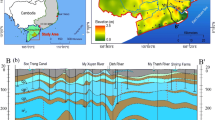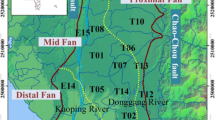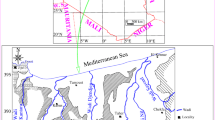Abstract
The Korba aquifer is located in the east of the Cape Bon peninsula in Tunisia. A large groundwater depression has been created in the central part of the aquifer since the 1980s, due to intense groundwater pumping for irrigation. The data collected show that the situation continues to deteriorate. Consequently, seawater is continuing to invade a large part of the aquifer. To better understand the situation and try to forecast its evolution, a three-dimensional (3D) transient density-dependent groundwater model has been developed. The model building process was difficult because of data required on groundwater discharge from thousands of unmonitored private wells. To circumvent that difficulty, indirect exhaustive information including remote sensing data and the physical parameters of the aquifer have been used in a multi-linear regression framework. The resulting 3D model shows that the aquifer is over-exploited. It also shows that after 50 years of exploitation, the time needed to turn back to the natural situation would be about 150 years if the authorities would ban all exploitation now. Such an asymmetry in the time scales required to contaminate or remediate an aquifer is an important characteristic of coastal aquifers that must be taken into account in their management.
Résumé
L’aquifère de Korba est localisé à l’est de la péninsule du Cap Bon en Tunisie. Une large dépression d’eau souterraine a été créée dans la partie centrale de l’aquifère depuis les années 80 à cause d’un pompage intense des eaux souterraines, utilisées pour l’irrigation. Les données collectées montrent que la situation continue à se détériorer. En conséquence, l’eau de mer continue d’envahir une grande partie de l’aquifère. Pour mieux comprendre cette situation et essayer d’estimer l’évolution de l’intrusion, un modèle hydrogéologique tridimensionnel en régime transitoire et à densité variable a été développé. La construction du modèle a été difficile à cause du manque de données sur les pompages à partir de milliers de puits privés non contrôlés. Pour résoudre cette difficulté, l’information exhaustive indirecte incluant les données d'images satellites et les paramètres physiques de l’aquifère a été utilisée dans une analyse de régression multilinéaire. Le résultat du modèle 3D montre que l’aquifère est surexploité. Il indique aussi qu’après 50 ans d’exploitation le temps nécessaire au retour à la situation naturelle serait d’environ 150 ans dans le cas où dans le cas où les autorités interdisent toute exploitation de l’aquifère. Cette asymétrie dans l’échelle de temps nécessaire pour contaminer ou améliorer un aquifère est une importante caractéristique des aquifères côtiers qui doit être prise en compte pour leur gestion.
Resumen
El acuífero Korba está localizado en el este de la península Cape Bon en Túnez. Una gran depresión de aguas subterráneas fue creada en la parte central del acuífero desde los años 1980, debido a un bombeo intenso de aguas subterráneas para la irrigación. Los datos colectados muestran que la situación continúa deteriorándose. Consecuentemente, el agua de mar está continuamente invadiendo una gran parte del acuífero. Para entender mejor la situación y tratar de pronosticar su evolución, se desarrolló un modelo tridimensional (3D) transitorio de aguas subterráneas dependiente de la densidad. El proceso de confección del modelo fue dificultoso debido a que los datos necesarios sobre la descarga de aguas subterráneas provienen de miles de pozos privados no monitoreados. Para salvar esta dificultad, se utilizaron la información exhaustiva indirecta que incluye datos de sensores remotos y los parámetros físicos del acuífero en un marco de regresión multi-lineal. El modelo 3D resultante muestra que el acuífero es sobreexplotado. También muestra que después de 50 años de explotación, el tiempo requerido para retornar a la situación natural sería de alrededor de 150 años si las autoridades prohibieran toda la explotación ahora. Semejante asimetría en las escalas de tiempo requeridas para contaminar o remediar un acuífero constituyen una característica importante de los acuíferos costeros que deberían ser tenidos en cuenta en su manejo.
摘要
Korba含水层位于突尼斯Cape Bon半岛东部。由于1980s以来大量抽取地下水用于灌溉, 在含水层中部已形成大面积的地下水降落漏斗。收集到的资料表明形势仍持续恶化。结果, 海水继续入侵大部分含水层。为了更好地了解状况, 并尝试预测其演化, 建立了一个三维 (3D) 非稳态变密度地下水模型。模型的建立过程很困难, 因为需要从数千口的未作监测的私用井取得所需的地下水排泄量数据。为了解决这些困难, 将各种间接的信息, 包括遥感数据和含水层的物理参数纳入一个多线性回归框架中。三维模拟结果表明含水层处于超采状态。模型还显示, 在开采50后, 如果当局从现在开始全面禁止开采, 要恢复到天然状态也将需要约150年。污染和修复一个含水层的时间尺度如此不对称。这是海岸带含水层的一个重要特征, 在管理当中须作考虑。
Resumo
O aquífero de Korba está localizado na parte leste da península de Cap Bon na Tunísia. Desde 1980 que foi criada uma grande depressão piezométrica na parte central do aquífero, devido a uma intensa exploração de águas subterrâneas para a agricultura. Os dados observados mostram que a situação se continua a deteriorar. Em consequência, a água do mar continua a invadir uma grande parte do aquífero. Para melhor se compreender a situação e tentar prever a sua evolução, foi desenvolvido um modelo 3-D em regime variável em função da densidade. O processo de construção do modelo foi difícil, devido à carência de dados de milhares de furos privados, não monitorizados. Para ultrapassar esta dificuldade, toda a informação indirecta, incluindo detecção remota e parâmetros físicos do aquífero, foi utilizada para um estudo de regressão inversa multi-linear. O modelo 3-D resultante mostra que o aquífero está numa situação de sobre-exploração. Mostra também que, após 50 anos de exploração, o tempo necessário para recuperação e retorno à situação natural seria de 150 anos, mesmo que as autoridades banissem toda a exploração neste mesmo momento. Tal assimetria nas escalas temporais para contaminar o aquífero e para o recuperar constitui uma das características mais importantes dos aquíferos costeiros, a qual deve ser tomada em consideração na sua gestão.














Similar content being viewed by others
References
Abarca E, Carrera J, Sanchez-Vila X, Voss CI (2007) Quasi-horizontal circulation cells in 3D seawater intrusion. J Hydrol 339:118–129
Abbes A, Polak M (1981) La formation Saouaf dans les synclinaux de la Dakhla (Cap-Bon) et de Saouaf (Tunisie nord orientale) [The Saouaf formation in the Dakhla (Cape Bon) and Saouaf (North-east Tunisia) synclines]. Notes Serv Géol Tunisie 46:99–111
Allen RG, Pereira LS, Raes D, Smith M (1998) Crop evapotranspiration: guidelines for computing crop water requirements. FAO Irrigation and drainage paper 56. FAO, Rome
Anderson M, Kustas W (2008) Thermal remote sensing of drought and evapotranspiration. EOS Trans Am Geophys Union 89:233–240
Archie GE (1942) The electrical resistivity log as an aid in determining some reservoir characteristics. Trans Am Inst Min Metall Pet Eng 146:54–61
Bastiaanssen WGM, Menenti M, Feddes RA, Holtslag AAM (1998a) A remote sensing surface energy balance algorithm for land (SEBAL): 1. formulation. J Hydrol 213:198–212
Bastiaanssen WGM, Pelgrum H, Wang J, Ma Y, Moreno JF, Roerink GJ, van der Wal T (1998b) A remote sensing surface energy balance algorithm for land (SEBAL): 2. validation. J Hydrol 213:213–229
Bear J, Cheng AHD, Sorek S, Ouazar D, Herrera I (1999) Seawater intrusion in coastal aquifers-concepts, methods and practices. Kluwer, Dordrecht, The Netherlands
Becker MW (2006) Potential for satellite remote sensing of ground water. Ground Water 44:306–318
Bensalem H (1992) Contribution à l’étude de la Géologie du Cap Bon: Stratigraphie, tectonique et sédimentologie [Contribution to the study of the geology of Cape Bon: stratigraphy, tectonic and sedimentology]. PhD Thesis, Faculté des Sciences de Tunis, Tunisia
Bensalem H (1995) Evolution de la Péninsule du Cap Bon (Tunisie nord-orientale) au cours du Néogène [Evolution of the Cape Bon peninsula (north-east Tunisia) during the Neogen]. Notes Serv Géol Tunisie 61:73–84
Bensalem H (1998) Les formations post Saouaf des environs de Nabeul (Cap Bon) et leur équivalents off shore et en Tunisie sud atlasique [The formations post Saouaf in the vicinity of Nabeul (Cape Bon) and their equivalents off shore and in south atlasic Tunisia]. Notes Serv Géol Tunisie 64:123–128
Bredehoeft JD (2002) The water budget myth revisited: why hydrogeologists model. Ground Water 40:340–345
Brunner P, Hendricks Franssen HJ, Kgotlhang L, Bauer-Gottwein P, Kinzelbach W (2007) How can remote sensing contribute in groundwater modeling? Hydrogeol J 15:5–18
Carrera J, Alcolea A, Medina A, Hidalgo J, Slooten LJ (2005) Inverse problem in hydrogeology. Hydrogeol J 13(1):206–222
Cheng AHD, Ouazar D (2003) Coastal aquifer management: monitoring, modeling, and case studies. Lewis, Boca Raton, FL
Coudrain-Ribstein A, Pratx B, Talbi A, Jusserand C (1998) Is the evaporation from phreatic aquifers in arid zones independent of the soil characteristics? CR Acad Sci Paris Earth Planet Sci 326:159–165
CRDA (2002) Rapport d’activités Commissariat Régional au Développement Agricole de Nabeul [Activity report of the Commissariat Régional au Développement Agricole de Nabeul]. Ministère de l’Agriculture et des Ressources Hydrauliques, Tunis, Tunisia
Custodio E (2002) Aquifer overexploitation: What does it mean? Hydrogeol J 10:254–277
DGRE (1985) Rapport d’exploitation des nappes phréatiques de l’année 1985 [Report of exploitation of the groundwater of the year 1985]. Direction Générale des Ressources en Eau, Ministère de l’agriculture et des ressources hydrauliques, Tunis, Tunisia
DGRE (2000) Rapport d’exploitation des nappes phréatiques de l’année 2000 [Report of exploitation of the groundwater of the year 2000]. Direction Générale des Ressources en Eau, Ministère de l’Agriculture et des Ressources Hydrauliques, Tunis, Tunisia
Diersch HG (1996) Interactive, Graphics-Based Finite Element Simulation System FEFLOW For Modeling Groundwater Flow, Contaminant Mass and Heat Transport. WASY Institute, Berlin, Germany
Doherty J (1998) PEST: model independent parameter estimation, Watermark, Brisbane, Australia
Ennabli M (1980) Etude hydrogéologique des aquifères du nord-est de la Tunisie pour une gestion intégrée des ressources en eau [Hydrogeological study of the aquifers north-east of Tunisia for an integrated management of the water resources]. PhD Thesis, Université de Nice, France
Gambolati G, Putti M, Paniconi C (1999) Three-dimensional model of coupled density-dependent flow and miscible transport in groundwater. In: Bear et al (eds) Seawater intrusion in coastal aquifers: concepts, methods, and practices. Kluwer, Dordrecht, The Netherlands, pp 315–362
Grava M (2005) Hydrochemical, hydrogeological, and geostatistical analysis of Eastern Cape Bon aquifer (northern Tunisia), Postgraduate Thesis, Centre d’hydrogéologie de l’Université de Neuchâtel, Switzerland
Hendricks Franssen JH, Brunner P, Makobo P, Kinzelbach W (2008) Equally likely inverse solutions to a groundwater flow problem including pattern information from remote sensing images. Water Resour Res 44, W0149. doi:10.1029/2007WR006097
Hichri H (2003) Annuaire hydro-pluviométrique du Cap Bon [Hydro-rainfall directory of the Cape Bon]. Ministère de l’Agriculture et des Ressources Hydrauliques, Tunis, Tunisia
INM (2001) Almanach [The climat]. Institut National de la Météorologie, Tunis, Tunisia. http://www.meteo.tn/ Cited August 2008
INS (2004) Recensement Général de la Population et de l’Habitat de 2004 [General census of population and housing 2004]. Institut National de la Statistique, Tunis, Tunisia. http://www.ins.nat.tn/. Cited August 2008
Käser D (2004) Etude hydrogéologique de la côte orientale du Cap Bon (Tunisie): apports de la télédétection à l’estimation du bilan hydrique [Hydrogeological study of the eastern coast of the Cape Bon (Tunisia): contributions of remote sensing to the estimation of water balance]. Postgraduate Thesis, Université de Neuchâtel, Switzerland
Khlaifi I (1998) Contribution à l’étude de l’intrusion marine par un modèle de transport tridimensionnel : interfaçage avec des systèmes d’information géographique [Contribution to the study of seawater intrusion by a three-dimensional transport model: interfacing with a geographic information system]. MSc Thesis, Institut National Agronomique de Tunisie, Tunisia
Konikow LF, Kendy E (2005) Groundwater depletion: a global problem. Hydrogeol J 13:317–320
Mami A, Aloui T (1982) Carte des ressources en sols de la Tunisie: feuille de la Goulette [Map of soil resources in Tunisia: the Goulette sheet]. Directions des sols, Ministère de l’Agriculture et des Ressources Hydrauliques, Tunis, Tunisia
Milnes E, Renard P (2004) The problem of salt recycling and seawater intrusion in coastal irrigated plains: an example from the Kiti aquifer (southern Cyprus). J Hydrol 288:327–343
Nazoumou Y (2002) Impact des barrages sur la recharge des nappes en zone aride : etude par modélisation numérique sur le cas de Kairouan (Tunisie centrale) [Impact of dams on aquifers recharge in arid zone: numerical modelling study at Kairouan (Central Tunisia)]. PhD Thesis, Ecole Nationale d’Ingénieurs de Tunis, Tunisia
Oueslati A (1994) Les côtes de la Tunisie. Recherche sur leur évolution au Quaternaire [The coasts of Tunisia: research on their evolution during the Quaternary]. Imprimerie officielle de la République Tunisienne, Tunis, Tunisia
Paniconi C, Khlaifi I, Lecca G, Giacomelli A, Tarhouni J (2001) Modeling and analysis of seawater intrusion in the coastal aquifer of eastern Cap-Bon, Tunisia. Transp Porous Med 43:3–28
Parodi GN (2002) AHVRR hydrological analysis system: algorithms and theory, Version 1.3. WRES-ITC, Enschede,The Netherlands
Roerink GJ, Su Z, Menenti M (2000) S-SEBI: a simple remote sensing algorithm to estimate the surface energy balance. Phys Chem Earth, Part B Hydrol Oceans Atmos 25:147–157
Scanlon BR, Tyler SW, Wierenga PJ (1997) Hydrologic issues in arid, unsaturated systems and implications for contaminant transport. Rev Geophys 35:461–490
Steenhuis TS, Van der Molen WH (1986) The Thornthwaite-Mather procedure as a simple engineering method to predict recharge. J Hydrol 84:221–229
Tarhouni J, Jemai S, Walraevens K, Rekaya M (1996) Caractérisation de l’aquifère côtier de Korba au Cap Bon (Tunisie) [Characterization of the Korba coastal aquifer in the Cape Bon (Tunisia)]. Progress report 95–96 for AVI-73 EC Project, EC, Brussels
Winsauer WO, Shearin HM, Masson PH, Williams M (1952) Resistivity of brine-saturated sands in relation to pore geometry. AAPG Bull 36:253–277
Acknowledgements
This work has been funded by the Swiss National Science Foundation under Grants: 207020-110017 and PP002-106557. Additional funds were provided by the Swiss Agency for Development and Cooperation and by the Institut National Agronomique de Tunisie. The authors thank G. de Marsily, R. Ababou, P. Perrochet, J. Carrera, R. Bouhlila and A. Alcolea for providing valuable suggestions on the manuscript. The authors are also grateful to Naceur Oueslati from CRDA Nabeul, and Emna Trabelsi from INAT who kindly provided the data.
Author information
Authors and Affiliations
Corresponding author
Rights and permissions
About this article
Cite this article
Kerrou, J., Renard, P. & Tarhouni, J. Status of the Korba groundwater resources (Tunisia): observations and three-dimensional modelling of seawater intrusion. Hydrogeol J 18, 1173–1190 (2010). https://doi.org/10.1007/s10040-010-0573-5
Received:
Accepted:
Published:
Issue Date:
DOI: https://doi.org/10.1007/s10040-010-0573-5




